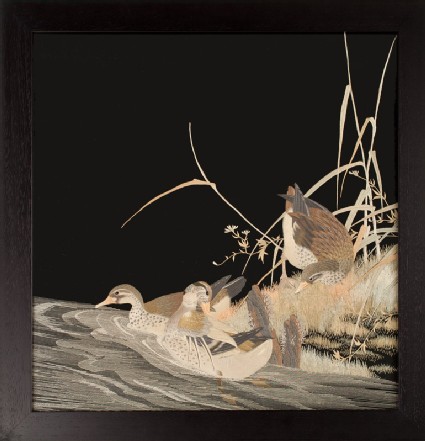Browse: 77 objects
Ducks by a river bank
- loan
-
Description
This deceptively simple-looking embroidery uses highly sophisticated needlework to depict the ducks’ feathers, their webbed feet, the grassy river bank, and the flowing river water. Swimming ducks were a popular motif on the decorative arts of this period, not least because the underwater sections of the ducks offered excellent opportunities for craftsmen to display their technical skills. A metalwork example [EA1956.1787] is also shown here. (Exhibition number 9)
-
Details
- Associated place
-
Asia › Japan › Honshū › Kyōto prefecture › Kyoto (probable place of creation)Europe (original location)
- Date
-
late 19th century - early 20th century
Meiji Period (1868 - 1912)
- Material and technique
- silk, satin woven, dyed black, and embroidered with coloured silk
- Dimensions
-
frame 60.1 x 57.4 x 5 cm (height x width x depth)
textile 72 x 67 cm (height x width)
- Material index
-
organic › animal › animal product › silk
- Technique index
-
dyed,
- Object type index
- No. of items
- 1
- Credit line
- Lent by the Kiyomizu Sannenzaka Museum.
- Accession no.
- LI1956.2
-
Further reading
Oxford: Ashmolean Museum, 9 November 2012-27 January 2013, Threads of Silk and Gold: Ornamental Textiles from Meiji Japan, Clare Pollard, ed. (Oxford: Ashmolean Museum, 2012), no. 9 p. 100, illus. pp. 98-100
Past Exhibition
see (1)-

Threads of Silk and Gold: Ornamental Textiles from Meiji Japan
(from 9th Nov 2012 until 27th Jan 2013)
Location
-
- returned to owner
Objects are sometimes moved to a different location. Our object location data is usually updated on a monthly basis. Contact the Jameel Study Centre if you are planning to visit the museum to see a particular object on display, or would like to arrange an appointment to see an object in our reserve collections.
Publications online
© 2013 University of Oxford - Ashmolean Museum





